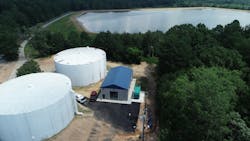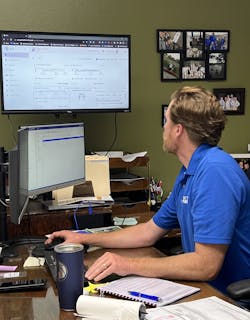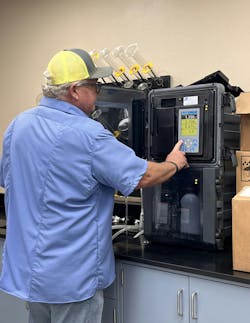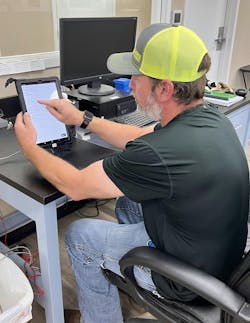Ready data analytics a game changer for the City of Kilgore
The City of Kilgore, Texas, delivers clean water to around 14,000 residents over roughly 160 miles of distribution lines.
Five operators manage the city’s water, and a big part of their job is collecting data such as flow, pressure, chemical usage and disinfection residuals. The city has a 3.5 million gallons daily (MGD) surface water treatment plant, a 3.5 MGD groundwater treatment plant and seven groundwater wells. To manage the water flow between these facilities there is a raw water pump station, two water pressure plants and over four million gallons in storage facilities.
Clay Evers, director of Public Works for the City of Kilgore, manages the operational data for the water treatment plant.
“We have multiple filing cabinets of daily data sheets completed by our operators. I enter most of the production data into Excel when I have time or need to do a report or troubleshoot a problem,” said Evers. “We do capture some data in our work order management system, but it is in a SQL database, so you have to mine the data, which is essentially cutting and pasting into a spreadsheet to create graph trend lines. It’s challenging and requires a certain level of sophistication, and it is labor intensive.”
It can be hard for small utilities to keep up with new technology.
“Our budgets are small, and our personnel are primarily focused on operations, and in most cases, they have been with us for quite some time,” said Evers. “To incorporate technology means changing the way things have been done for years and often decades. Crossing the technology chasm is not always easy, it takes training and users have to buy in that the end result is more meaningful than the status quo. This takes time and proof.”
Nitrification event drives the need for data management
Late last year, the city had a nitrification event and was unable to keep acceptable chlorine residuals in the distribution system. Evers started entering data into Excel to look at trend lines and see when this had started and if he could determine where and why it happened.
“By graphing out the data in Excel, I could see the trend started three months prior,” said Evers. “This was a real eye-opener to the fact that we really need to be able to analyze our data every day, and we needed a program that makes it really easy for all our operators to use and see what is happening and flag potential issues as soon as they happen.”
This event led to a free chlorine conversion, which involves removing ammonia (needed to form chloramine) from the treatment process and disinfecting the water with only chlorine. This was followed by flushing a lot of water. Evers and his team also needed time to diagnose the problem that needed to be rectified. These kinds of events are costly and preventable with a modern data management program like Rio, a software program for regulatory compliance and operational data management.
“At around the same time as this event, I was scouring the internet to see what other small treatment plants were doing. I got an email from Aquatic Informatics, as we use Hach instruments to collect field data. The opening line was, ‘Are you tired of doing spreadsheets?’ I most certainly was, and I booked a demo!” said Evers.
Prior to Rio, if Evers wanted to know how much water the city produced in a day, someone had to find paper files and make the calculation by subtracting the day’s flow meter reading from the previous day’s flow meter reading. There are seven wells, so it had to be done seven times.
“The daily water production is a number that we all should know but it was labor intensive to determine,” said Evers. “Using Rio, we now have this information at our fingertips — it’s fully automated. Furthermore, with one click we can graphically see the entire month, and soon the year. This will help us to identify anomalies, predict how much water we need, and help with conservation efforts.”
Interfacing with SCADA for quick reporting
Rio is also interfacing with the city’s SCADA databases.
“The software does the math on all data collected by SCADA, including filter turbidity and chlorine residuals, and gives the minimums, maximums, and averages which I also need for monthly reporting,” said Evers. “I can compare SCADA data with operator’s entries and catch errors much more easily.”
A couple of operators are now entering data through the Rio mobile app, while others prefer using a desktop to enter the data. The mobile app can run off any smartphone or touchscreen tablet, which is often more appealing to the new generation of workers who grew up with these devices.
Before implementing Rio, monthly operating reports took several hours for operators to complete, as it was a manual process of finding the right data and entering it. Evers worked with Rebecca Henzi, an implementation specialist at Aquatic Informatics to build out a template in Rio that auto-fills 90% of the information required in the report.
The origin of most of this data, such as flow, residuals, and turbidity, comes into the program from SCADA. Once a variable is entered into Rio it automatically calculates and populates data into the report, dashboards, trend lines, and any other reporting templates that the city chooses.
Streamlining operations with access to data
In a couple of clicks Evers can now graph flow or chemical usage, or any other measured parameters to ensure operations are running smoothly or quickly identify anomalies.
In one example the city had an unseen leak in a chemical line, which was clear to spot on a graph in Rio as it showed two simultaneous days of usage at 75 lbs, but typically the treatment plant uses 150 lbs.
“This kind of data was never put into a spreadsheet, so having this visibility and all the calculations to give us the numbers we need for analysis, and visually see it on a chart, means it’s hard to miss and we can quickly address issues,” said Evers.
Accumulating data and having it all in one accessible program increases the value of the data over time, not only for predicting future outcomes, but in instances where the plant needs upgrading. Having the data available is invaluable when a consulting engineer asks for five years’ worth of operating data to begin designing plant improvements. Good data ensures the right sizing.
Having been in the municipal water industry for over 23 years, Evers is committed to process improvement. He knows that technology can help remove redundancies and some labor-intensive tasks, freeing up his time to be more proactive. Quick access to historical operational data will help with the planning of maintenance and budgeting for equipment replacement or upgrades.
“If you have the right tools built by people from the industry you can make better decisions,” said Evers. “What I like about Rio is it’s easy to implement and well-priced, it’s already saving us time and as we get into using more of the functionality. I can see our capabilities expanding which is important for a small utility like ours. We have the same requirements as the bigger utilities, but we have fewer resources to achieve the same result — safe drinking water.”
About the Author

Kevin Koshko
Sedaru Product Director
Kevin Koshko is the Water Treatment Data Management Product Manager at Aquatic Informatics. He brings over 24 years of experience helping municipalities and water professionals solve some of their biggest challenges. Kevin has spent the last two decades as a software developer, architect, and product manager and a licensed water distribution and wastewater treatment operator.



